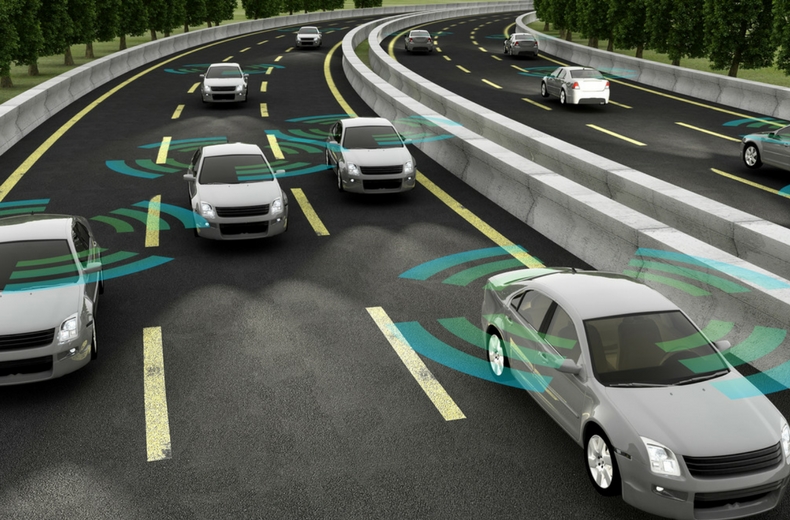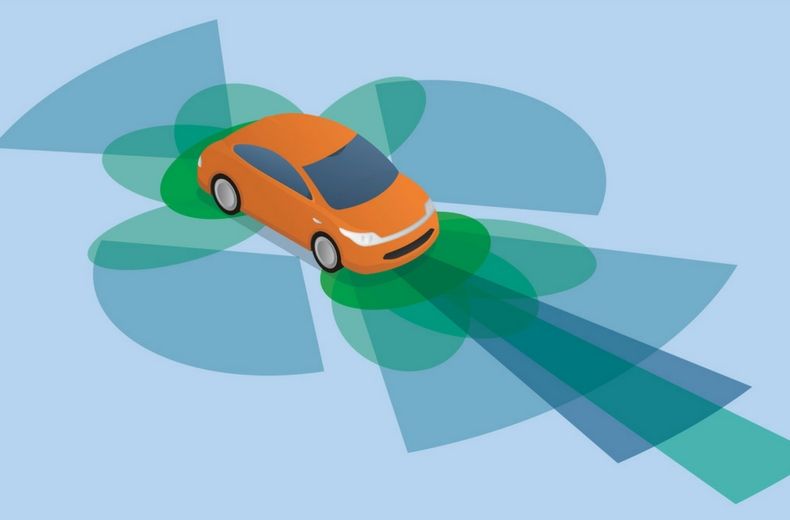Autonomous Emergency Braking (AEB) is one of the biggest road safety breakthroughs in recent memory – giving vehicles the capacity to slow themselves down when faced with a potential accident.
AEB is such an important potential lifesaver it's now been written into law. All new cars sold in the EU (and the UK) since May 2022 must have the system fitted as standard.
What is AEB?
It’s a safety system built into vehicles which monitors the traffic and road conditions ahead for signs a collision might occur.
AEB warns a driver of an upcoming danger, before applying the brakes automatically if the driver doesn't respond within due time. When AEB activates it removes the 'thinking time' associated with driver's applying the brakes, meaning it can bring the car to a stop more quickly.
With AEB applied the speed at which a collision occurs can be decreased to a life-saving degree or, ideally, the impact is avoided altogether.
How does AEB work?
The way in which AEB technology reacts and operates differs by the vehicle make and model, and some systems are more sophisticated than others. But they all work using the same principles.
AEB systems use Lidar (light detection and radar) or camera sensors, or a combination of both, to help prevent potential accidents.
Information gleaned via these elements – together with data on a vehicle’s travel speed and trajectory – helps the AEB system to decide whether a hazardous situation is developing.
When detecting a potentially critical situation most systems will first try to warn the driver that action is needed. If no driver action is taken and the AEB system judges a collision is expected, the brakes will be applied automatically.
READ MORE: Driverless cars: a guide to current and future tech
How sudden is the braking impact?

The AEB system will determine the necessary brake force needed to be applied. This can vary between an elevated level, and full braking force – with the aim of reducing the speed at which a collision will take place.
Different AEB systems have different operating speed ranges and there are separate types of hazards they can identify. For example, some systems are most effective in low speed urban areas, while others can also handle rural or multi-lane driving.
While systems have different capabilities, the technology is constantly adapting and improving, heading towards an AEB system with the capacity to avoid collisions altogether.
Can AEB stop collisions with pedestrians?
The newer the car, the more likely it is to have the most advanced and effective AEB systems. Early systems could only operate at lower speeds, but now pretty much all new cars have a system that operates up to (and beyond) the national speed limit.
Studies suggest the latest AEB systems are much more effective at stopping the car than systems fitted in the late 2010s.
More recently, an increasing majority of new cars also use camera systems to identify and avoid collisions vulnerable road users, such as pedestrians and cyclists, as well as cars. They can also function at night, which earlier systems couldn't.
You'll want to check out the brochure of equipment list for a new car to find out if the most advanced system is fitted. It'll usually list something like "Autonomous Emergency Braking with pedestrian and cyclist detection". Only cars equipped with this will achieve the higher four and five-star European New Car Assessment Programme (Euro NCAP) safety ratings.
Why is AEB so important?
Not only can it reduce the speed at which a collision happens, it has the potential to stop the crash happening in the first place.
A 2015 study by The European New Car Assessment Programme (Euro NCAP) and Australasian NCAP found that AEB led to a 38% reduction in real-world rear-end crashes.
Researchers at the University of Adelaide also found in a study of 104 crashes, AEB could have reduced fatal collisions by 20-25% and the likelihood of injury by 25–30%.
Where seatbelts and airbags are in place to protect passengers in the case of a crash, AEB aims to reduce the likelihood of a crash happening in the first place.
Thatcham – a research centre that specialises in vehicle safety – said at the time AEB is “probably the most significant development in car safety since the seatbelt and could save an astonishing 1,100 lives and 122,860 casualties in the UK over the next 10 years.”
READ MORE: Euro NCAP launches automated technology timeline
Which cars are fitted with AEB?

Only a decade ago, most new cars on sale were not fitted with any form of AEB. The system was first debuted at the Detroit Motor Show way back in 1996, but it took nearly 20 years to be fitted to mainstream cars.
Famously safety conscious Volvo was the first carmaker to make AEB mandatory on all of its new cars way back in 2014. Jaguar Land Rover followed in 2016. By 2019, Euro NCAP began penalising cars fitted without the system in testing.
Today, however, all new cars sold in the EU and the UK must be fitted with it as standard. That was applied in May 2022, which means you can't buy a new car today (except perhaps a specialist, low-volume sports car) without the system on board.
READ MORE: Top 10 safety features modern cars should have as standard
What else is AEB called?
Various names have been adopted by manufacturers which feature elements of AEB technology across their model range:
| Manufacturer | AEB name |
|---|---|
| Audi | Adaptive Cruise Control with Pre Sense Front Pre-Sense Front Pre-Sense City |
| BMW | Driving Assistant Driving Assistant Plus Active Guard |
| Citroen | Active City Brake |
| Fiat | City Brake Control Brake Control |
| Ford | Active City Stop Pre Collision Assist Active Braking |
| Honda | Collision Mitigation Braking System City Brake Active System |
| Hyundai | Autonomous Emergency Braking |
| Infiniti | Forward Collision Warning & Intelligent Brake Assist (Safety Shield) Forward Collision Emergency Braking Intelligent Cruise Control with Emergency Brake (Dynamic Safety Shield) Forward Collision Warning & Intelligent Brake Assist |
| Jaguar | Autonomous Emergency Braking |
| Jeep | Forward Collision Warning Plus Forward Collision Plus |
| Land Rover | Autonomous Emergency Braking |
| Lexus | Pre Crash System Adaptive Cruise Control System with Pre Crash Safety |
| Mazda | Smart City Braking Support |
| Mercedes | Collision Prevention Assist 3.0 Distronic Plus |
| Mini | Driving Assistant |
| Mitsubishi | Forward Collision Mitigation |
| Nissan | Forward Emergency Braking |
| Peugeot | Active City Brake Emergency Collision Alert with Emergency Braking |
| Porsche | Adaptive Cruise with Porsche Active Safe |
| Range Rover | Autonomous Emergency Braking |
| Renault | Active Emergency Braking |
| Seat | Adaptive Cruise Control with Front Assist Safety Assist Front Assist |
| Skoda | City Safe Drive Front Assist |
| Subaru | Eyesight |
| Suzuki | Radar Brake Support |
| Tesla | Automatic Emergency Braking |
| Toyota | Pre-Crash System |
| Vauxhall | Forward Collision Warning with Automatic Brake Intervention Front Camera + Emergency Braking Front Camera + Emergency Braking Adaptive Cruise and Stop Go |
| Volkswagen | Front Assist Including City Emergency Braking City Emergency Braking |
What other car safety developments are now commonplace?
While we're still some way off fully self-driving cars, you'll find impressive autonomous features to help make driving safer and more stressful.
Tesla's Autopilot system - which uses multiple external cameras to automatically keep the car at the correct speed and assist in steering within a marked lane - is the most well-known system on the market. The system can even change lanes on motorways, with a 'Beta' system allowed for certain owners that can effectively drive the car entirely from a motorway on-ramp to an off-ramp.
Such systems are not unique to Tesla, however. Most premium brands, as well as a number of mainstream car makers, offer such a system. These are 'Level 2' autonomous systems, defined as partial driving automation - able to steer, drive and park themselves in certain circumstances, but with the driver always defined as being in control.
Ford's BlueCruise system, launched in the UK in 2023, was the first of its kind to allow hands-free driving on certain sections of UK motorway. It's available on the Mustang Mach-E on a monthly subscription basis, but this is still a Level 2 system requiring the driver to stay alert and take control if needed.
There are some systems, such as Mercedes-Benz Drive Pilot and BMW's Personal Pilot, that operate Level 3 autonomy - allowing automated driving in certain conditions such as geo-fenced areas of the motorway. These are not yet legal for us in the UK, however.
Away from autonomous driving, there are multiple safety features becoming increasingly common. Lane keep assist (which makes steering inputs to stop you straying from your lane) is another system made mandatory in 2022. Camera-based driver monitoring and Intelligent Speed Adaptation (which can automatically change the car's speed when the limit changes ahead) are also part of this.
Further systems include Blind Spot Monitoring (which warns you if a car is in your blind spots on the motorway or dual carriageway), Cross-Traffic Alert (which warns you if cars are crossing in front or behind you when parking) and Safe Exit Assist (which spots if cars or cyclists are approaching and stops you opening your door into them) are now increasingly commonplace.

RAC sale – up to 33% off*
• Roadside cover from £5.29 a month†
• We get to most breakdowns in 60 mins or less
• Our patrols fix 4/5 breakdowns on the spot












